2020 Ford Escape Is Much Improved—and Surprisingly Quick
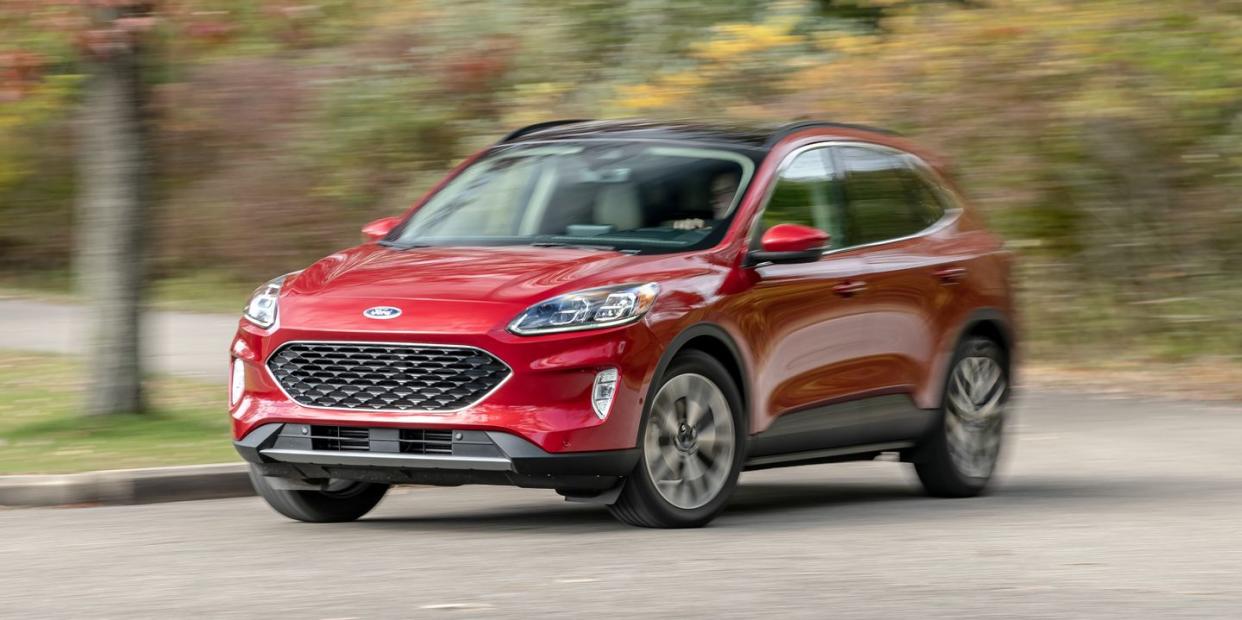
10/25/19 UPDATED: This review has been updated with test results for both the Escape 1.5L and 2.0L models.
The redesigned 2020 Ford Escape comes to market this fall at a time when compact SUVs have become sales darlings that move in big numbers. With high stakes in dealer showrooms and an onslaught of fresh competition from Subaru, Toyota, and Volkswagen, among many others, Ford pulled out the stops to create a pleasantly rounded fourth-generation Escape that brings enough smart features and model configurations to satisfy a variety of buyers.
The new Escape is slightly longer, wider, and lower than the outgoing model and has a lower beltline that allows for larger windows and excellent outward visibility. The expansive greenhouse combined with the plunging nose can give this Ford the look of a swollen hatchback on stilts, yet the overall design is hardly offensive. More important, the new model is notably lighter than before, largely thanks to the use of more high-strength steel in its structure, which helped lend a general easiness and sense of agility to the examples we've driven, both through the rolling hills of Kentucky and back at our Michigan base.
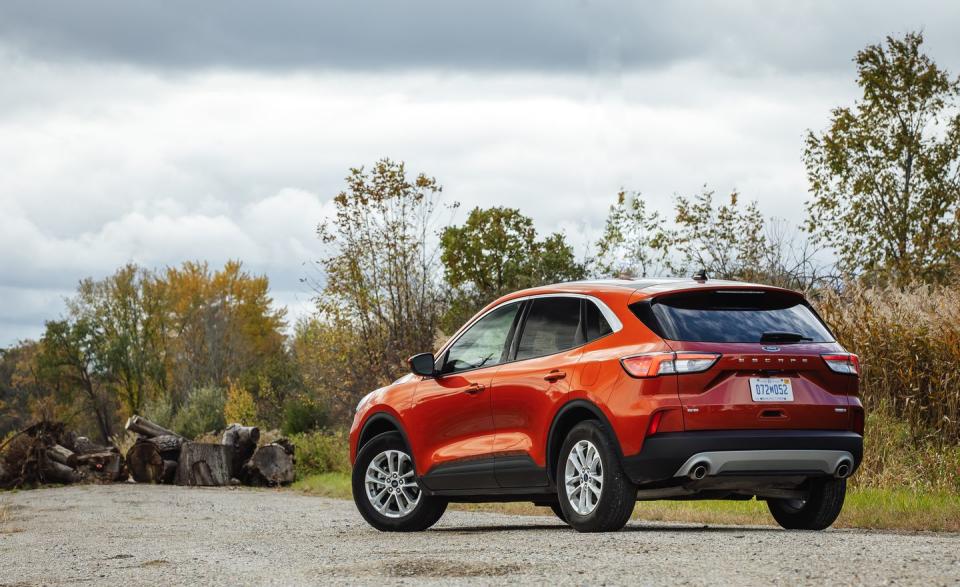
Pick Your Player
Multiple trim levels (S, SE, hybrid-only SE Sport, SEL, and Titanium) along with four powertrains—two gasoline engines, a hybrid, and a plug-in hybrid that will launch in the spring—make for a wide array to choose from. Front-wheel drive is standard on all but the all-wheel-drive-only nonhybrid Titanium; all-wheel drive is a $1500 option on all other trim levels. The Escape's base powerplant, a turbocharged 1.5-liter inline-three-cylinder, produces 181 horsepower and 190 lb-ft of torque, which comes on quickly and relatively smoothly and is fully adequate for getting this compact ute up to a moderate pace. Which is a good thing, considering it is the only mill to be had on S and SE trim levels. The run from zero to 60 mph in our all-wheel-drive SE test car takes 7.7 seconds, and the quarter-mile is dispatched in 15.9 seconds at 87 mph—leagues ahead of the 9.2- and 16.9-second measurements we recorded for a previous-generation front-drive Escape with the now-defunct turbo 1.5-liter inline-four. There's a throaty warble to the triple's engine note under load that could only come from an inline-three. Our one complaint is some faint boominess inside the cabin when the cylinder-deactivation system occasionally kicks in and idles one of the cylinders.
Far more compelling is the upgrade, turbocharged 2.0-liter inline-four, which only is available on the Titanium and the all-wheel-drive SEL, for $2285. The more powerful 2.0-liter develops its 250 horses and 280 lb-ft of torque with a quiet purr and turns the Escape into a borderline hot rod among compact SUVs. Our Titanium test car, at 3731 pounds, compressed our scales with 109 fewer pounds than its all-wheel-drive predecessor with an optional 245-hp 2.0-liter turbo four. The new version's 5.7-second dash to 60 mph and 14.3-second quarter-mile pass at 96 mph are, again, huge improvements over the previous model's times and enough to easily make the Escape the fleetest player in the segment.
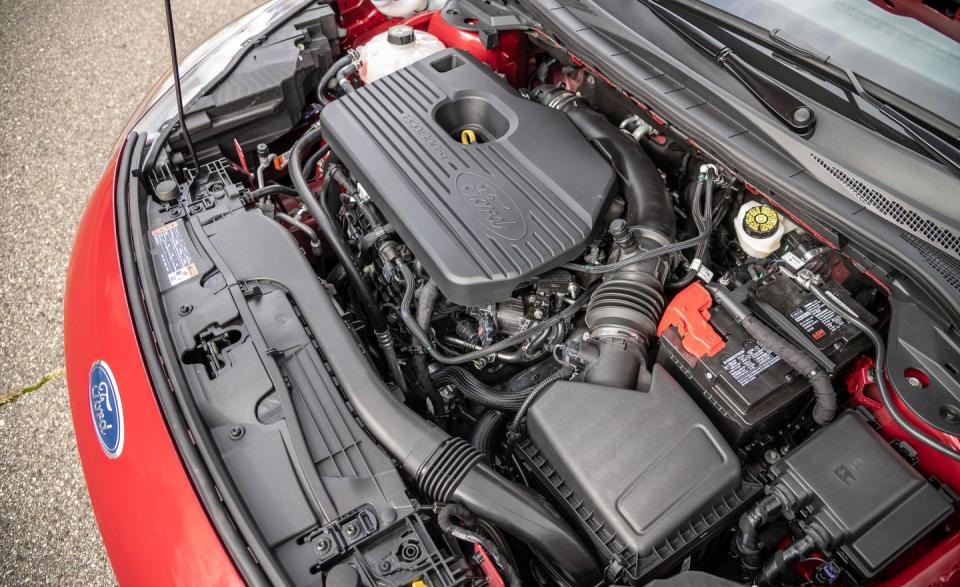
While the overall driving experience with the boosted 2.0-liter still is not exactly exhilarating, throttle response is quite good, and its overall refinement should make Honda CR-V and Toyota RAV4 drivers envious. There's no word yet on if Ford plans to introduce a zestier ST variant using the platform-sharing Lincoln Corsair's 280-hp 2.3-liter turbo four, but we'd be surprised if Ford didn't capitalize on the opportunity to make the Escape into the only semi-high-performance player among nonluxury compact utes. Opting for the 2.0-liter unlocks the Ford's maximum towing capacity of 3500 pounds; models with the 1.5-liter are limited to 2000 pounds, and the hybrids can tug only 1500.
Both gas engines are paired with an eight-speed automatic transmission that, aside from some low-speed stutters when pulling to a stop, shifts quickly and unobtrusively, adding to the Escape's smooth character. All trim levels feature five drive modes selectable via a console button (Normal, Eco, Sport, Slippery, and Snow/Sand) and mainly work to adjust the response of the engine and transmission. On models equipped with the optional 12.3-inch digital gauge cluster, changing the modes triggers a vibrant and distracting animation that temporarily consumes virtually the entire instrument display. That annoyance aside, the Sport setting makes the greatest difference to the Escape's road behavior, allowing it to rev a touch more eagerly and hold gears longer, although the eight-speed still remains a bit lazy on downshifts for spirited driving.
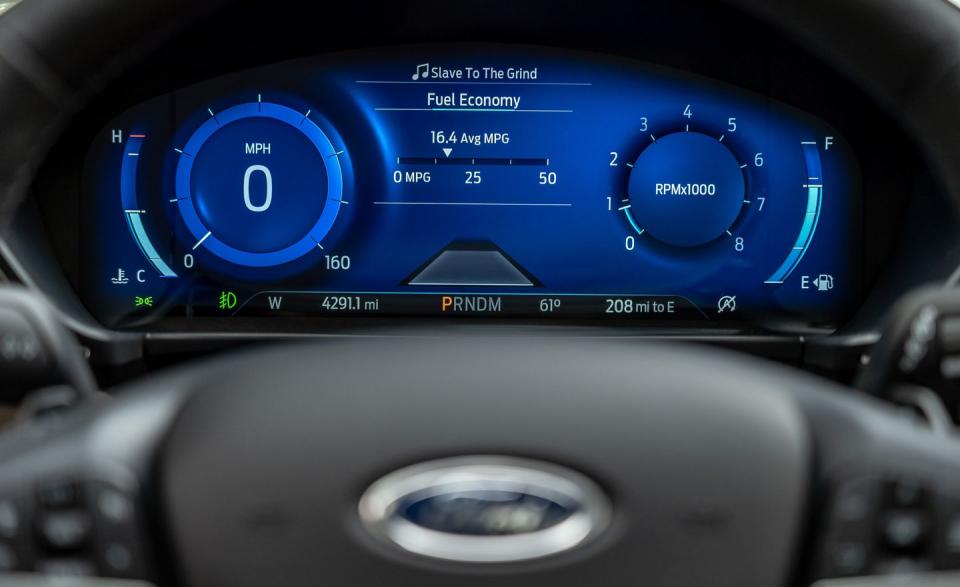
The new Escape's EPA fuel-economy numbers jump by a dramatic 3 to 4 mpg for the 1.5T and 2.0T powertrains; the hybrid's figures haven't yet been finalized but should be approaching 40 mpg. Our lackluster average fuel economy both with the 1.5-liter SE (26 mpg) and the 2.0-liter Titanium (22 mpg) were the result of rather aggressive driving conditions. But the SE did clock a solid 35 mpg on our 75-mph highway fuel-economy test, with the Titanium managing 32 mpg.
Hybrid Assist
Those looking for maximum efficiency surely will search out the Escape hybrid, which starts at $29,450 in SE Sport guise and $34,595 in Titanium trim. Serving as a pleasant middle ground between the two conventional powertrains, the hybrid pumps out a combined 200 horsepower from a 2.5-liter Atkinson-cycle inline-four mated to a planetary gearset and two electric motors, which essentially function as a continuously variable automatic transmission. We didn't get to drive the upcoming front-drive-only plug-in-hybrid model with its 14.4-kWh lithium-ion battery, claimed 30 miles of electric-only range, and additional driving modes that let the driver determine how to deploy or save its electric juice. But even the standard hybrid with its small, 1.1-kWh battery beneath its floorboards is effective and nicely sorted.
While the hybrid's 2.5-liter is not as smooth in operation as the two turbo engines, the additional boost from electrons give it a decent punch when its accelerator is buried. And there's enough current on tap to accelerate from rest up to about 30 mph at a reasonable, albeit gentle, pace. The system's complex gearbox works in the background to keep engine droning to a pleasing minimum. We found the Eco driving mode to work the best, by only slightly tempering throttle response and maximizing the energy capture from regenerative braking. In use, the regenerative function blends seamlessly with the friction brakes when pulling to a stop, which is no small feat in any hybrid.
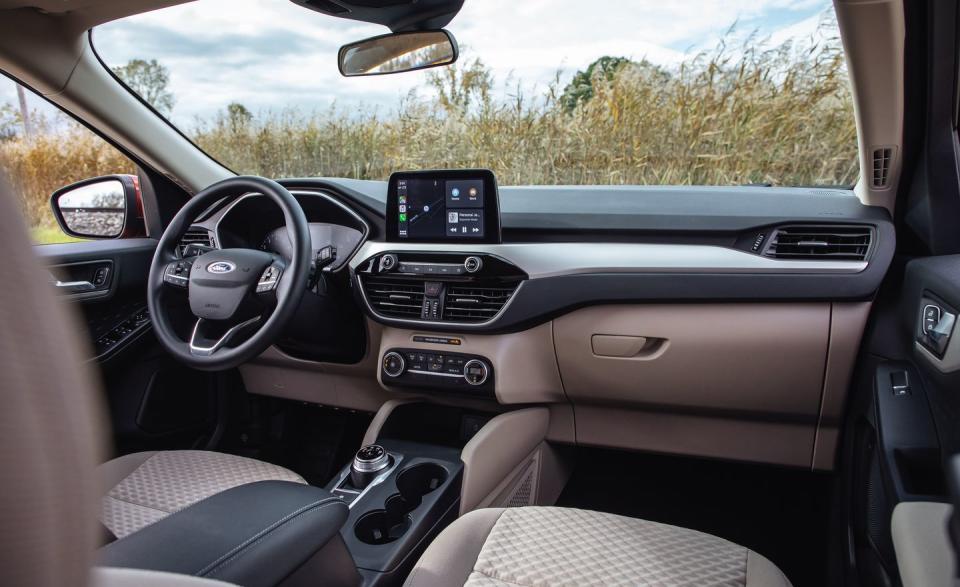
Ford says the hybrid can shut down its gas engine and briefly cruise on electric power up to 85 mph. Our drive route on city streets, through suburbia, and out on twisty country roads didn't include time on the highway, yet the Escape did spend a substantial amount of miles calmly coasting on electricity alone—and its indicated average fuel economy never dipped below 40 mpg. We'll see how it fares when we get a test car on our familiar commutes and testing routes.
Quiet, Capable, and Spacious
Regardless of which model you choose, all Escapes drive with competence, refinement, and cushy ride quality, thanks in part to an isolated rear subframe that's attached to the chassis with bushings; the outgoing model's is solidly mounted. Most of our time was spent in versions fitted with the optional 19-inch wheels, but 17s and 18s also are available and make little difference to the Escape's dynamic performance measurements. Our Titanium model, rolling on 19s wrapped with 225/55R-19 all-season tires, orbited the skidpad with a decent 0.85 g of lateral grip and stopped from 70 mph in a tidy 168 feet. The 237-pound-lighter SE model, despite its 17-inchers and 225/65R-17 all-season rubber, produced a similar 0.84 g of grip and trimmed six feet from the 2.0T's stopping distance.
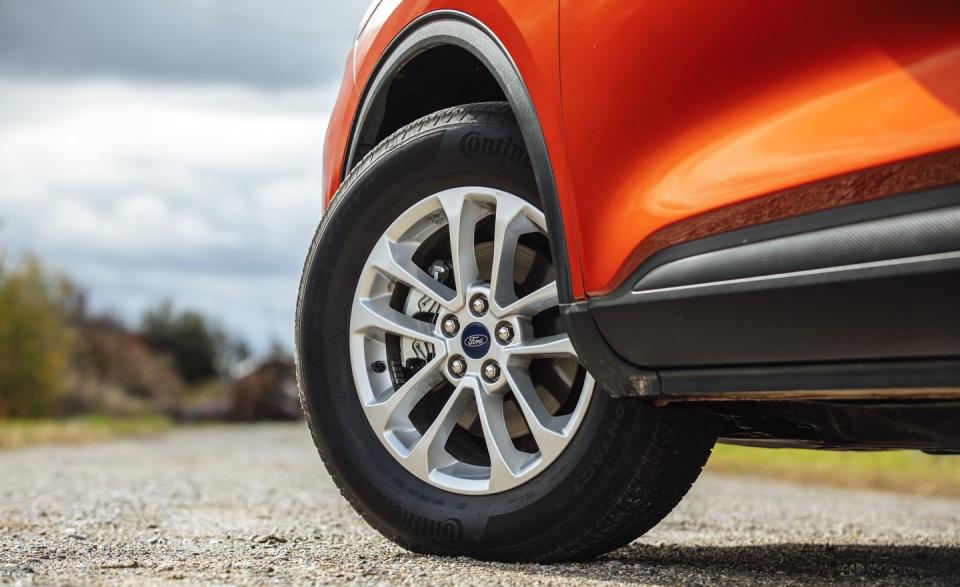
The brake pedal in both gas and hybrid Escapes is reassuringly firm; the electrically assisted steering is dull in feedback yet welcomingly precise; and body control from the strut front and multilink rear suspension is well-managed around corners for something this compliantly sprung. The Mazda CX-5 has no chance of being dethroned as the driver's choice in this segment. But this Ford strikes a commendable balance of comfort and capability, and our test cars were calmingly quiet inside, both emitting an easy-listening 70 decibels of noise at a 70-mph cruise.
The other major takeaway of the Escape's redesign is improved interior space. Ford notes that at least four full-size golf bags can fit behind the Escape's split-folding rear seats, which now slide fore and aft on a six-inch track and also recline. Cargo capacity of 34 cubic feet in conventional models (hybrids lose three cubes in accommodating their batteries) matches that of the previous Escape, but slide the seats all the way forward, and it grows to 38 cubic feet, which is nearly as much as the capacious Honda CR-V. Even in the rear seats, six-footers can't complain about personal space, although it's easy to take issue with the Escape's hard-plastic door panels, sizeable gaps between the dash and door plastics, and generally uninspired material finishes, even in the top-spec Titanium.
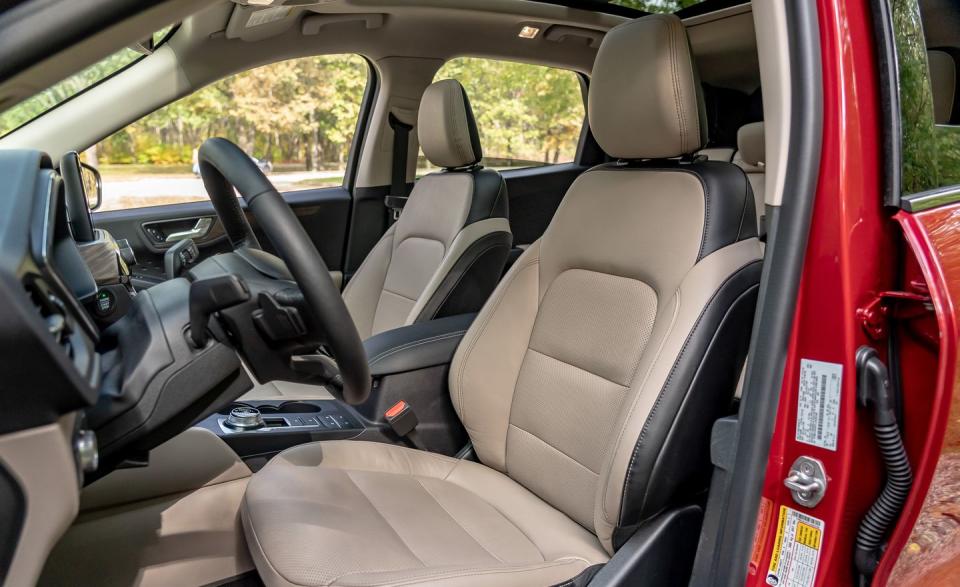
Ford's steering-wheel controls and driver-information menus still are more cryptic than we'd like, but overall ergonomics are decent, and the optional 8.0-inch central touchscreen infotainment system is highly intuitive and loaded with connectivity options (Ford says additional power outlets and a wireless device-charging pad will be added after launch). Titanium models also feature an optional 6.0-inch head-up display that flips out of the top of the dash, rather than a more conventional setup that projects an image directly onto the windshield. But we didn't find it that useful, given its proximity to the much larger digital gauge cluster.
Along with an amply adjustable seating position with generous sightlines, drivers also will appreciate the Escape's standard Ford Co-Pilot360 suite of active safety tech, including the effectiveness of its lane-centering system on the highway, as well as its optional adaptive cruise control, evasive-steering assist functions, and updated self-parking abilities. With an entry point only $880 higher, at $26,080, and fully loaded models topping $40K, the fourth-gen Ford Escape's price range is as expansive as the rest of its attributes. There's no doubt that Ford comprehensively improved its top-selling SUV.
You Might Also Like

